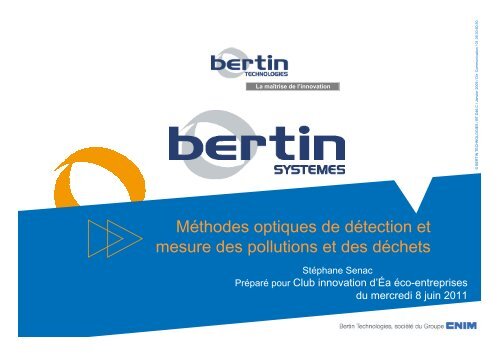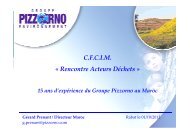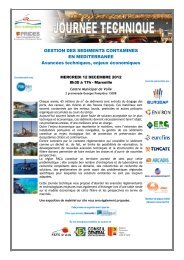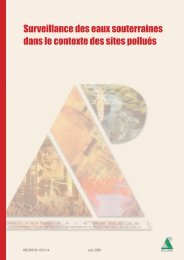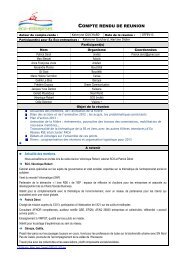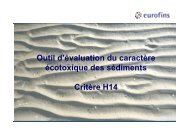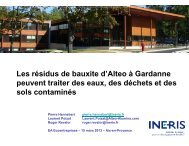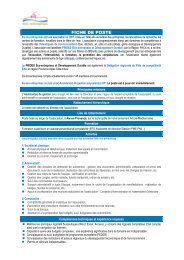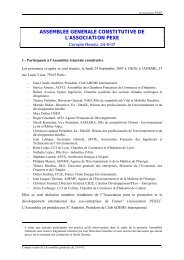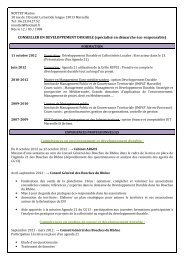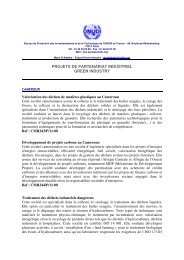Méthodes optiques de détection et mesure des pollutions et des ...
Méthodes optiques de détection et mesure des pollutions et des ...
Méthodes optiques de détection et mesure des pollutions et des ...
- No tags were found...
You also want an ePaper? Increase the reach of your titles
YUMPU automatically turns print PDFs into web optimized ePapers that Google loves.
La maîtrise <strong>de</strong> l’innovation<br />
© BERTIN TECHNOLOGIES / BT.D46.C / Janvier 2009 / Dir. Communication / 01.39.30.60.50.<br />
<strong>Métho<strong>de</strong>s</strong> <strong>optiques</strong> <strong>de</strong> <strong>détection</strong> <strong>et</strong><br />
<strong>mesure</strong> <strong>de</strong>s <strong>pollutions</strong> <strong>et</strong> <strong>de</strong>s déch<strong>et</strong>s<br />
Stéphane Senac<br />
Préparé pour Club innovation d’Éa éco-entreprises<br />
du mercredi 8 juin 2011
Sommaire<br />
Aperçu rapi<strong>de</strong> <strong>de</strong> Bertin Technologies<br />
BT.D46.C<br />
Technologies <strong>optiques</strong> appliquées à l’environnement / l’offre Bertin<br />
Technologies<br />
Spectroscopie Laser pour l’environnement :<br />
Zoom sur la Détection <strong>de</strong> contaminants par LIBS / LIF<br />
Zoom sur le Tri optique <strong>de</strong> déch<strong>et</strong>s par LIBS<br />
05020-980-SL018-A<br />
07/06/2011 - Confi<strong>de</strong>ntiel<br />
2
Bertin :<br />
Plus <strong>de</strong> 50 ans d’innovation technologique<br />
BT.D46.C<br />
> 1956<br />
> 1965<br />
> 1975<br />
> 1992<br />
> 1999<br />
> 2007<br />
> 2009<br />
Création <strong>de</strong><br />
Bertin <strong>et</strong> Cie par<br />
l’ingénieur<br />
d’exception<br />
Jean Bertin<br />
Aérotrain<br />
Silencieux<br />
d’échappement<br />
pour centrales<br />
nucléaires<br />
Premier automate<br />
<strong>de</strong> séquençage du<br />
génome humain<br />
Modélisation du<br />
lanceur ARIANE V<br />
Collecteur<br />
d’aérosols<br />
biologiques<br />
Détecteur <strong>de</strong> gaz<br />
chimiques par<br />
imagerie<br />
05020-980-SL018-A<br />
07/06/2011 - Confi<strong>de</strong>ntiel<br />
3
Bertin Technologies <strong>et</strong> Bertin Pharma :<br />
sociétés du Groupe CNIM<br />
CNIM : CHIFFRES CLÉS S 2009<br />
Chiffre d’affaires consolidé<br />
~ 580 M€<br />
BT.D46.C<br />
Effectif groupe<br />
Implantation<br />
3 350 personnes<br />
21 pays dans le mon<strong>de</strong><br />
SECTEURS<br />
ENVIRONNEMENT<br />
ÉNERGIE<br />
INNOVATION<br />
& SYSTEMES<br />
• Eco-parcs<br />
• Unités <strong>de</strong> valorisation <strong>de</strong><br />
déch<strong>et</strong>s ménagers <strong>et</strong> industriels<br />
• Traitement <strong>de</strong>s fumées<br />
• Maintenance <strong>et</strong> rénovation <strong>de</strong><br />
chaudières industrielles<br />
• Traitement <strong>de</strong> l’air <strong>et</strong> <strong>de</strong> l’eau<br />
• Energie Solaire<br />
• CNIM /Division Systèmes Avancés<br />
: Energie nucléaire <strong>et</strong> Industrie<br />
• Bertin<br />
CNIM couvre tout le cycle <strong>de</strong><br />
vie du produit<br />
> R&D<br />
> Ingénierie<br />
> Fabrication<br />
> Installation<br />
> Exploitation <strong>et</strong> SAV<br />
05020-980-SL018-A<br />
07/06/2011 - Confi<strong>de</strong>ntiel<br />
4
Bertin Technologies en bref<br />
500 collaborateurs dont plus <strong>de</strong> 400 ingénieurs, biologistes <strong>et</strong> pharmaciens<br />
BT.D46.C<br />
Secteurs d’activités<br />
Implantations<br />
Sciences du Vivant<br />
22%<br />
Industrie &<br />
Services<br />
10%<br />
Énergie & Environnement<br />
21%<br />
Défense &<br />
Sécurité<br />
32%<br />
Aéronautique &<br />
Espace<br />
15%<br />
Montigny<br />
le Br<strong>et</strong>onneux<br />
Orléans<br />
Pessac<br />
Tarnos<br />
Blagnac<br />
Aix<br />
Electronique<br />
Optique<br />
Traitement du signal<br />
Mécanique<br />
Effectif : 61 personnes<br />
Notre métier : Étu<strong>de</strong>, expertise, développement <strong>de</strong> produits innovants<br />
05020-980-SL018-A<br />
07/06/2011 - Confi<strong>de</strong>ntiel<br />
5
Exemple <strong>de</strong> développement dans le domaine <strong>de</strong><br />
l’optique <strong>et</strong> <strong>de</strong> la chimie : Second Sight<br />
Détection <strong>de</strong> gaz chimique par<br />
imagerie infrarouge<br />
BT.D46.C<br />
Second Sight :<br />
Facile d’utilisation<br />
Large champ <strong>de</strong> vision<br />
Alerte précoce <strong>et</strong> observation en<br />
temps réel<br />
Détection <strong>de</strong> nuage <strong>de</strong> gaz<br />
à l’extérieur (vidéo en temps réel)<br />
05020-980-SL018-A<br />
07/06/2011 - Confi<strong>de</strong>ntiel<br />
6
BioAérosols<br />
(diamètre typique<br />
particules : 1 – 5 µm)<br />
Coriolis ® : biocollecteur durci pour le théâtre<br />
d’opération<br />
Prélève <strong>et</strong> concentre tous les pathogènes<br />
aériens (charbon, peste, <strong>et</strong>c.)<br />
Produit un échantillon liqui<strong>de</strong> compatible<br />
avec tout type d’analyse<br />
BT.D46.C<br />
Coriolis ® MS : Caractéristiques<br />
spécifiques pour les applications militaires<br />
Coriolis ® FR : dédié aux premiers<br />
secours<br />
05020-980-SL018-A<br />
07/06/2011 - Confi<strong>de</strong>ntiel<br />
7
Technologies optique pour l’environnement chez<br />
Bertin Technologies<br />
INDUSTRIE CHIMIQUE ET PETROCHIMIQUE<br />
Télé<strong>détection</strong> <strong>de</strong> gaz par imagerie multispectrale IR<br />
Alerteur chimique pour la <strong>détection</strong> <strong>de</strong> Toxiques industriels (absorption IR<br />
/ FTIR)<br />
BT.D46.C<br />
SANTE / PHARMACIE / AERONAUTIQUE<br />
Biocollection associée à <strong>de</strong> l’i<strong>de</strong>ntification biologique (procédé<br />
d’immunoagglutination <strong>et</strong> lecture par voie optique)<br />
<br />
Traitement <strong>de</strong> l’air par couplage <strong>de</strong> rayonnement UV <strong>et</strong> photocatalyse<br />
ENVIRONNEMENT / RECYCLAGE<br />
Détection <strong>de</strong> polluants, contamination <strong>de</strong> surfaces par spectroscopie<br />
laser (LIF, LIBS, Raman) => contrôle <strong>de</strong> contamination Biologique <strong>et</strong> ou<br />
chimique<br />
Tri <strong>de</strong>s déch<strong>et</strong>s par LIBS : polymères, métaux, réfractaires<br />
05020-980-SL018-A<br />
07/06/2011 - Confi<strong>de</strong>ntiel<br />
8
Spectroscopie laser pour l’environnement<br />
Analyse par spectroscopie laser<br />
BT.D46.C<br />
LIF : Laser Induced Fluorescence<br />
Spectroscopie Raman<br />
LIBS : Spectroscopie <strong>de</strong> plasma induit par<br />
laser(Laser-Induced Breakdown Spectroscopy)<br />
Zoom sur quelques Exemples d’applications<br />
Contamination chimique <strong>et</strong> biologique<br />
Tri <strong>de</strong>s déch<strong>et</strong>s<br />
05020-980-SL018-A<br />
07/06/2011 - Confi<strong>de</strong>ntiel<br />
9
LIF <strong>et</strong> Spectroscopie Raman sur surfaces contaminées<br />
Agent<br />
Raie (cm -1 )<br />
Gain<br />
BT.D46.C<br />
GA<br />
2198<br />
10<br />
GB<br />
723<br />
3<br />
GD<br />
740<br />
1<br />
HD<br />
1292<br />
16<br />
L<br />
1554<br />
475<br />
VX<br />
1098<br />
24<br />
DMMP<br />
712<br />
1<br />
05020-980-SL018-A<br />
07/06/2011 - Confi<strong>de</strong>ntiel<br />
10
Détection <strong>de</strong> contaminants par LIBS (Cl,P,F,S….)<br />
4000<br />
3500<br />
Chlore<br />
800<br />
Phosphore<br />
BT.D46.C<br />
Intensité (u.a.)<br />
3000<br />
2500<br />
2000<br />
1500<br />
Intensité (u.a.)<br />
700<br />
600<br />
500<br />
400<br />
Phosphore<br />
1000<br />
825 830 835 840 845 850<br />
Longueur d'on<strong>de</strong> (nm)<br />
Simulant <strong>de</strong> moutar<strong>de</strong> à l’azote<br />
300<br />
252.0 252.5 253.0 253.5 254.0 254.5 255.0 255.5 256.0<br />
Longueur d'on<strong>de</strong> (nm)<br />
Simulant <strong>de</strong> sarin<br />
Un<strong>de</strong>r sudy :<br />
Raman / LIF / LIBS<br />
Double pulse LIBS<br />
Many surfaces<br />
05020-980-SL018-A<br />
07/06/2011 - Confi<strong>de</strong>ntiel<br />
11
Spectroscopie Raman en <strong>de</strong>ep UV : influence <strong>de</strong> l’excitation<br />
BT.D46.C<br />
05020-980-SL018-A<br />
07/06/2011 - Confi<strong>de</strong>ntiel<br />
12
Contamination biologique <strong>de</strong> surface : exemple <strong>de</strong> travaux par LIBS<br />
BT.D46.C<br />
Figure 1 : ACP sur bactéries, protéine <strong>et</strong> surface seule (M1A, M1B <strong>et</strong> M1C)<br />
Figure 1 : D escripteur SF Fe en fonction <strong>de</strong> SF Na<br />
Figure 1 : ACP sur MS2, CpGV <strong>et</strong> surface seule (M1A, M1B <strong>et</strong> M1C)<br />
Figure 1 : D escripteur SF K en fonction <strong>de</strong> SF N<br />
05020-980-SL018-A<br />
07/06/2011 - Confi<strong>de</strong>ntiel<br />
13
Développement <strong>de</strong> la spectroscopie <strong>de</strong> plasma induit par laser<br />
Principes Physiques :<br />
Génération d’un plasma par<br />
focalisation d’une impulsion laser<br />
Atomes <strong>et</strong> ions excités dans le<br />
plasma : émission <strong>de</strong> lumière<br />
Raies spectrales émises<br />
caractéristiques <strong>de</strong>s éléments<br />
présents<br />
Analyse spectrale perm<strong>et</strong> <strong>de</strong><br />
remonter à la composition<br />
élémentaire<br />
Intensité <strong>de</strong>s raies émises liée à la<br />
concentration (<strong>mesure</strong><br />
quantitative)<br />
05020-980-SL018-A<br />
07/06/2011 - Confi<strong>de</strong>ntiel<br />
• Exemple spectre matrice Zr<br />
14<br />
BT.D46.C
AVANTAGES DE LA TECHNIQUE<br />
AVANTAGES<br />
<br />
<br />
<br />
<br />
<br />
<br />
<br />
Presque tous les éléments du tableau <strong>de</strong><br />
Men<strong>de</strong>leïev peuvent être analysés<br />
Mesure sans préparation d’échantillon<br />
Compatible soli<strong>de</strong>, liqui<strong>de</strong>, gaz<br />
Analyse rapi<strong>de</strong> <strong>et</strong> temps réel (=>Possibilité<br />
Intégration sur ligne <strong>de</strong> Production)<br />
Métho<strong>de</strong> non <strong>de</strong>structive<br />
Mesure sans contact à distance<br />
Mesure dans environnement contraint ( Haute<br />
Température ..)<br />
BT.D46.C<br />
LIMITES<br />
<br />
<br />
Mesure ponctuelle<br />
Limite <strong>de</strong> <strong>détection</strong> <strong>de</strong> l’ordre du ppm à quelques<br />
dizaines <strong>de</strong> ppm (suivant les éléments)<br />
05020-980-SL018-A<br />
07/06/2011 - Confi<strong>de</strong>ntiel<br />
15
De la R&D à la production…<br />
Partenariat avec le CNRS (LP3)<br />
100<br />
BT.D46.C<br />
Proportion (%)<br />
10<br />
1<br />
0,1<br />
N e<br />
C<br />
C+<br />
C 2<br />
H<br />
H+<br />
H 2<br />
N<br />
N+<br />
N 2<br />
CH<br />
CN<br />
0,01<br />
4000 6000 8000 10000 12000<br />
Température (K)<br />
Analyse <strong>et</strong> modélisation <strong>de</strong> spectres LIBS<br />
Étu<strong>de</strong> <strong>de</strong><br />
l’évolution<br />
spatiotemporelle<br />
<strong>de</strong>s<br />
raies<br />
05020-980-SL018-A<br />
07/06/2011 - Confi<strong>de</strong>ntiel<br />
16
Exemple d’application : Recyclage / Tri <strong>de</strong> pièces<br />
réfractaires<br />
Pour un industriel parmi les lea<strong>de</strong>rs mondiaux <strong>de</strong> la production <strong>de</strong> pièces<br />
réfractaires pour la coulée continue <strong>de</strong> l ’acier :<br />
discrimination rapi<strong>de</strong> <strong>de</strong> pièces sur le terrain<br />
investigation du potentiel pour l’analyse rapi<strong>de</strong> <strong>de</strong> nuances<br />
Autres techniques : FluoX, Spark OES non compatibles<br />
BT.D46.C<br />
Pièces : 3 bases principales Al, Mg, Zr<br />
Nuances : exemples d’éléments à discriminer<br />
Si O Ti Al Fe Ca Mg Zr Hf Na<br />
6.51 34.10 0.00 0.23 0.22 0.29 39.89 0.00 0.00 0.07<br />
6.93 36.75 0.04 0.46 0.43 0.59 42.42 0.11 0.00 0.20<br />
1.80 27.57 0.00 1.01 0.12 0.19 35.58 0.84 0.02 0.00<br />
3.48 34.52 0.04 1.96 0.24 0.62 39.56 2.17 0.07 0.08<br />
1.30 37.22 0.00 3.51 0.00 0.39 47.41 0.18 0.00 0.00<br />
2.56 44.54 0.00 6.69 0.00 0.74 49.22 0.40 0.00 0.00<br />
0.14 31.20 0.00 0.16 0.22 0.37 46.46 0.23 0.00 0.00<br />
0.31 33.60 0.00 0.35 0.47 0.80 49.00 0.50 0.00 0.00<br />
0.39 32.24 0.00 1.62 0.19 0.32 43.82 0.00 0.00 0.00<br />
Les nuances se distinguent par leur teneur en Si, Zr, Al, Mg, Ca, Ti, Fe, C, <strong>et</strong> B<br />
05020-980-SL018-A<br />
07/06/2011 - Confi<strong>de</strong>ntiel<br />
17
Exemple d’application : Tri <strong>de</strong> polymères (manuel)<br />
<br />
<br />
<br />
<br />
Capteur transportable intégrant le laser<br />
optimisé en longueur d’on<strong>de</strong><br />
Coffr<strong>et</strong> contrôle comman<strong>de</strong> associé<br />
intégrant le PC<br />
Support échantillon<br />
Logiciel <strong>de</strong> traitement adaptable à<br />
l’application ou ouvert pour étu<strong>de</strong> <strong>de</strong><br />
procédé<br />
Applications possibles<br />
Tri manuel <strong>de</strong> polymères<br />
Contrôle qualité métaux<br />
Analyse liqui<strong>de</strong> <strong>et</strong> gaz (via<br />
cellule annexe)<br />
I<strong>de</strong>ntification <strong>de</strong> réfractaires,<br />
contrôle <strong>de</strong> MIX<br />
…..<br />
05020-980-SL018-A<br />
07/06/2011 - Confi<strong>de</strong>ntiel<br />
18<br />
BT.D46.C
Exemple d’application : Tri <strong>de</strong> polymères (manuel)<br />
Détection <strong>de</strong> charges <strong>et</strong> RF<br />
RF Halogénés via la <strong>détection</strong> <strong>de</strong> Sb<br />
Cl <strong>et</strong> Br<br />
Détection P<br />
Détection <strong>de</strong> Talc <strong>et</strong> fibre <strong>de</strong> verre via Mg, Ca, Si<br />
Autres éléments détectables : Al, ….<br />
BT.D46.C<br />
Si I 288<br />
Mg<br />
Si<br />
Figure 1 : Raie <strong>de</strong> silicium pour échantillon 118 (35 % <strong>de</strong> fibre <strong>de</strong> verre), 10 ème spectre. En<br />
noir : acquisition du 22/01/10. En vert : acquisition du 02/02/10.<br />
Figure 1 : Noir : spectre obtenu sur PE MD20. En vert : spectre obtenu sur un échantillon PP<br />
avec talc (n° 133) . Note : décalage spectral <strong>de</strong> 12,3 nm.<br />
05020-980-SL018-A<br />
07/06/2011 - Confi<strong>de</strong>ntiel<br />
19
20<br />
BT.D46.C<br />
05020-980-SL018-A<br />
07/06/2011 - Confi<strong>de</strong>ntiel<br />
Exemple d’application : Tri <strong>de</strong> polymères (manuel)<br />
0<br />
1008<br />
4<br />
9<br />
0<br />
0<br />
4<br />
Polyolefine<br />
0<br />
0<br />
3<br />
0<br />
0<br />
0<br />
0<br />
PC<br />
0<br />
0<br />
0<br />
3<br />
0<br />
0<br />
0<br />
PA<br />
0<br />
0<br />
0<br />
0<br />
3<br />
0<br />
0<br />
HIPS<br />
0<br />
0<br />
0<br />
0<br />
1<br />
25<br />
5<br />
ABSPC<br />
0<br />
0<br />
0<br />
0<br />
0<br />
0<br />
50<br />
ABS<br />
un<strong>de</strong>termination<br />
Polyolefine<br />
PC<br />
PA<br />
HIPS<br />
ABSPC<br />
ABS<br />
0<br />
1008<br />
4<br />
9<br />
0<br />
0<br />
4<br />
Polyolefine<br />
0<br />
0<br />
3<br />
0<br />
0<br />
0<br />
0<br />
PC<br />
0<br />
0<br />
0<br />
3<br />
0<br />
0<br />
0<br />
PA<br />
0<br />
0<br />
0<br />
0<br />
3<br />
0<br />
0<br />
HIPS<br />
0<br />
0<br />
0<br />
0<br />
1<br />
25<br />
5<br />
ABSPC<br />
0<br />
0<br />
0<br />
0<br />
0<br />
0<br />
50<br />
ABS<br />
un<strong>de</strong>termination<br />
Polyolefine<br />
PC<br />
PA<br />
HIPS<br />
ABSPC<br />
ABS
Exemple d’application : Tri <strong>de</strong> polymères (manuel)<br />
Performances typiques sur flux VHU <strong>et</strong> flux DEEE<br />
VHU Efficacité Pur<strong>et</strong>é DEEE Efficacité<br />
Pur<strong>et</strong>é<br />
BT.D46.C<br />
ABS<br />
PA<br />
PP<br />
PE<br />
>95%<br />
>85%<br />
>90%<br />
>95%<br />
>95%<br />
>80%<br />
>95%<br />
>90%<br />
PA<br />
Polyo<br />
ABS<br />
ABS/PC<br />
>90%<br />
>95%<br />
>90%<br />
> 85%<br />
>90%<br />
>95%<br />
>80%<br />
>85%<br />
PPGF<br />
>95%<br />
>95%<br />
ABS/HIPS<br />
>70%<br />
>70%<br />
PP+talc<br />
PA+talc<br />
>95%<br />
>95%<br />
>95%<br />
>90%<br />
Chlore/<br />
Brome<br />
>95% si<br />
Charge >5%<br />
>95% si<br />
Charge >5%<br />
PAGF<br />
>90%<br />
>90%<br />
05020-980-SL018-A<br />
07/06/2011 - Confi<strong>de</strong>ntiel<br />
Sous Gaz neutre , séparation ABS ; ABS/PC; PC;<br />
HIPS; PA; Polyo<br />
21
Intégration Technologie LIBS sur ligne <strong>de</strong> Production<br />
QUANTOM 200 : équipement <strong>de</strong><br />
tri en machine multivoie (métaux,<br />
polymères, verre….) :<br />
Capacité > 200 Kg/h<br />
Alimentation en continu sur un<br />
convoyeur vibrant repartis en 4<br />
voies<br />
Transfert sur Convoyeur Rapi<strong>de</strong><br />
pour amener les produits <strong>de</strong>vant<br />
les points <strong>de</strong> Mesures LIBS<br />
Concept configuration<br />
QUANTOM :<br />
<br />
<br />
N voies d’analyses<br />
> 200 ech / secon<strong>de</strong>s<br />
BT.D46.C<br />
Tri par Rampe <strong>de</strong> Buse<br />
05020-980-SL018-A<br />
07/06/2011 - Confi<strong>de</strong>ntiel<br />
22
Conclusion<br />
Les technologies <strong>optiques</strong> perm<strong>et</strong>tent <strong>de</strong> répondre aux enjeux<br />
actuels <strong>et</strong> à venir <strong>de</strong> l’environnement<br />
Détection <strong>de</strong> polluants (<strong>mesure</strong> in situ, minimisation prélèvements…)<br />
Eau, air, sols <strong>et</strong> déch<strong>et</strong>s<br />
Secteurs : Industrie (recyclage), santé, chimie <strong>et</strong> pétrochimie….<br />
BT.D46.C<br />
Offre croissante <strong>de</strong> Bertin Technologies dans ce domaine<br />
05020-980-SL018-A<br />
07/06/2011 - Confi<strong>de</strong>ntiel<br />
23
© BERTIN TECHNOLOGIES / BT.D46.C / Janvier 2009 / Dir. Communication / 01.39.30.60.50.<br />
La maîtrise <strong>de</strong> l’innovation<br />
CONTACT BERTIN TECHNOLOGIES<br />
Stéphane SENAC<br />
senac@bertin.fr<br />
Tel: +33 42 60 45 70
Processus avec un algorithme <strong>de</strong> reconnaissance <strong>de</strong> la surface (3)<br />
Fusion sur M1B<br />
BT.D46.C<br />
Conclusion i<strong>de</strong>ntique pour les autres surfaces (y compris le béton!)<br />
05020-980-SL018-A<br />
07/06/2011 - Confi<strong>de</strong>ntiel 25<br />
25


